
Guest Post by Peter Brown.
Who Killed the Chromoly Truck?
Who Killed the Chromoly Truck? Many months ago I posted a comment on Skate and Annoy having to do with the San Diego Trucking Company’s chromoly truck called the Stealth. I never saw a set in person and most of our readers had ever heard of this truck from the early 90s. They resembled the G&S chromoly truck almost exactly, and it turns out they have pretty much the same history, spanning three brief years between 1989 and 1991.
After digging through my extensive skate mag stash it appears that both G&S and San Diego advertised exclusively in Transworld. One of the San Diego ads listed 70s slalom champ, Henry Hester, aka “Bad H.” as a contact, and of course Bill Danforth (if not Phil E.) was the guy most closely associated with the G&S truck. So I was able to contact Bad H. and Danforth to ask them about these trucks, and Hester put me on to the inventor of the chromoly truck, Terry Myers. I also wound up getting snubbed by G&S, which for some reason didn’t surprise me. Most interestingly I corresponded through Facebook with someone claiming to be Phil E. After a couple emails the guy confessed to being a Phil E. imposter! I never would have guessed there was someone out there sick enough to live his life as if he were this late 80s curb gnarler turned legal prosecutor. After having divulged a lot of my personal financial information and innermost desires to a person I thought was the real Phil E. I feel taken advantage of.
Somewhere in the late 80’s, no one can remember exactly when, an inventor/engineer/tinkerer, Terry John Myers built the first chromoly truck on his picnic table. Chromoly is a high carbon steel alloy made of chromium and molybdenum, known for its lightness and strength. It’s widely used in BMX frame construction and in certain car parts.
Myers was connected to the skate industry through his work at Advanced Plastics in Chula Vista, CA which manufactured rails for G&S. Though he didn’t skate, his two sons did and he decided he wanted to make a truck that would not wear out. Through his business with G&S, Myers knew Henry Hester and showed Hester the homemade truck. Hester liked the idea of an indestructible truck and pitched it to G&S who apparently liked it also and released it in 1989. The first G&S trucks were fabricated by Zip Products, which Myers established purely to manufacture the G&S product.“
According the Hester, “the truck had close to Indy geometry that turned well according to my slalom sensibilities. The chromoly hanger provided a ‘slip grind’ capable of grinding curbs and coping that softer, conventional aluminum trucks could not.”
Responsiveness and an ability to grind almost anything were two attributes that should have given chromoly trucks wide appeal. I vaguely recall once trying someone’s board that had G&S trucks and they did grind the rough, old curbs in my neighborhood better than aluminum trucks. I don’t recall how heavy they were or how they turned though.
Around 1989 Hester recruited Danforth to ride for G&S. Danforth says “I liked the G&S truck for its responsiveness and ability to grind anything. Interestingly, the trucks were never really put to the test until after they were on the market. I guess I was the most abusive skater G&S could find [think Ohio Skateout acid drop]. My job was to test and improve the trucks and G&S would send me 20 trucks per month to destroy.”
The original G&S truck had a nylon baseplate, hardened steel alan bolt kingpins, and welded, hollow chromoly hanger parts. The hangers also had nylon end caps between the metal and the wheels; and a hanger pivot about the diameter of a pinky finger.
According to Myers, “the scale of our production, and the fact that I, the inventor was running things gave us a good deal of quality control. Through precise tempering and reliable workmanship, the trucks we made–the early G&S trucks–did not break.”
Despite the attention to detail at Zip, Danforth says there were a few problems with these G&S trucks, “The nylon baseplate cracked easily under Midwest winter skating conditions. I told them to just make a metal baseplate, which they did along with a metal reinforced nylon version. Aside from the baseplate, the endcaps wore down faster than the metal hanger and caused hang-ups. Now, the hollow axle was perfect for smoking weed.”
Zip Products had been producing the G&S truck for about a year when Larry Gordon of G&S decided to take production off shore, likely in an effort to reduce manufacturing costs. Hester recalls that “Since G&S was still under contract with Zip when they moved production, they had to make payments to Zip, and this arrangement led to disagreements between the two.” Apparently sweatshop production of the G&S product was not done as conscientiously as what Zip was doing. Myers traces the problem with the sweatshop G&S trucks to the improper tempering of the steel, which caused the chromoly to bend and break.
According to Danforth, “The biggest deficiency in the design was the pivot, which bent too easily. I’d do demos in front of all these kids and these trucks would break on me. It was kind of hard to sell those trucks after showing that my 125 pound frame could bend them after a few launches and grinds. I think of a guy like Monty Nolder [also sponsored by G&S Trucks] who’s 200-plus pounds just crushing these things.”
Hester stuck with G&S for a while after their switch to sweatshop production, and through Danforth’s destructive testing, the two improved the design for G&S. Ads show the truck design evolving a bit between 1989 and 1991 when it was marketed as the Phase II. The Phase II gave skaters the option of an aluminum baseplate with a threaded slot for the kingpin; or a nylon, metal reinforced baseplate. It had solid axles, and a triangular metal plate welded to the hanger to support the pivot. The triangular metal plate does not appear in any of the ads, which show the truck only from the kingpin side. All of this bulk made a stronger truck, but made it heavier too and likely more expensive to produce even overseas.
Since Zip was tooled up to make trucks and was sitting on a mountain of chromoly piping, Myers decided to start his own truck business. Meanwhile back at G&S, Hester was frustrated with a poor product despite his and Danforth’s efforts, so in 1990 he joined Myers in forming San Diego Trucking and Supply.
Through San Diego, Hester brought with him ideas developed by Danforth and him on how the G&S truck could have been improved. Hester describes the San Diego as a “beefier version of the same [G&S] truck under the SDTS label”. Hester handled the distribution, promotion and recruited a team of riders. San Diego sponsored a number of amateurs around the country, but apparently none who had a signature model board with another company.
Despite design improvements, an ability to turn well and grind almost anything, neither G&S or San Diego trucks ever sold as well as conventional, mass produced, cast aluminum trucks. It seems logical that with all the parts and processes to manufacture and assemble a chromoly truck there would have been a higher labor cost than its aluminum counterparts. The chromoly companies also didn’t benefit from the economy of scale like their bigger aluminum competitors. The economics of it are evident in the fact that chromollies ranged in price from $18 to $20 each while conventional cast aluminum trucks sold for about $16 per truck.
Said Henry Hester, “A year in to it, I re-designed a hanger for the Stealth with the triangular shape. It was intended to enter curbs and coping easier using the angle. The kids in the ads were sponsored. We paid Bill Danforth to ride the trucks and I’ve always believed he genuinely liked the slip grind. He may have been the best curb slapper ever.”
Whether it was due to narrow profits, poor sales or a shitty product, G&S abandoned the Phase II within a year of its release, and replaced it with the Danforth designed, aluminum Road Hawg. Despite the new truck that he designed, Danforth left G&S and went back to his original truck sponsor, Tracker.
This all coincided with street skating’s blow up in the early 90s and the vert-centric G&S loosing most of its top riders Chris Miller, Blender, Steve Claar, Billy Ruff and Nicky Guerrero [and replacing them with a trio of budgies]. With the new Rocco-generation of street skaters coming on the scene, a company from the 70s named after two aging white guys, Gordon & Smith, was just too uncool compared to a market flooded by wise-ass upstarts like Blind, New Deal, and Foundation. Nowadays G&S resides in the nostalgia and campus cruiser market.
Considering a large, established company like G&S failed with the chromoly truck despite their existing distribution, relatively small sweatshop labor costs, an ad budget, videos and big name skaters, it seems implausible that San Diego could survive. Despite a product characterized by Myers as superior to its G&S counterpart, and Hester’s connections to the industry, it would have likely been difficult for a higher priced, unconventional looking product from a start-up to compete against juggernauts like Indy, Tracker, and Gullwing. Also, the San Diego looked a lot like the G&S, which had a reputation for bending and breaking. If that weren’t enough the introduction of the San Diego truck during the Bush I recession was just bad luck. Coincidentally San Diego released the cast aluminum Stealth II the same year G&S came out with its Road Hawg.
Hester and Danforth both blame the trucks’ unconventional appearance for its failure and not all the reasons that in hindsight might seem obvious. Danforth claims that “to a lot of skaters the chromoly trucks looked more like a bike frame than a truck.” Hester also admits it was “heavy and not Indy cool. Cool killed it.”
Who Killed the Chromoly Truck? Guest Post by Peter Brown
PREVIOUS COMMENTS: In the old location.


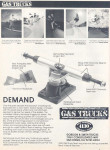
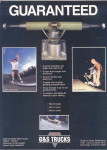
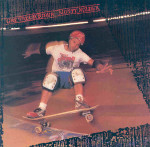



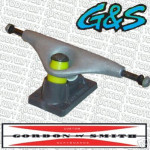
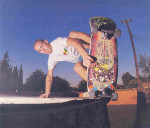
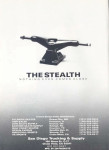




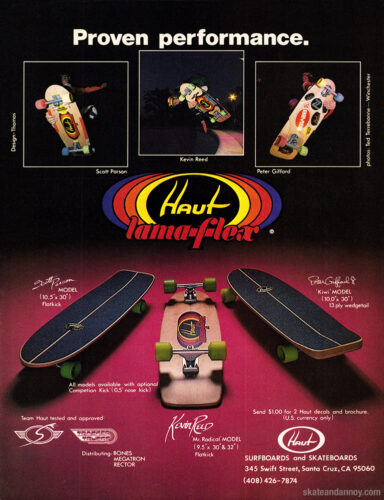
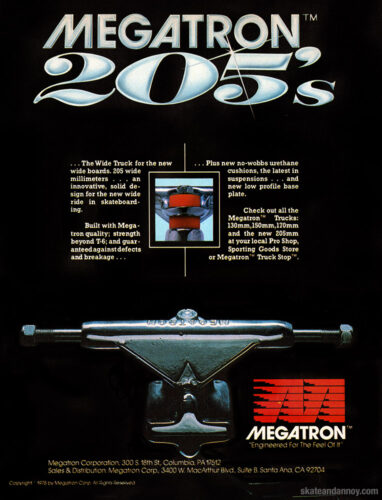
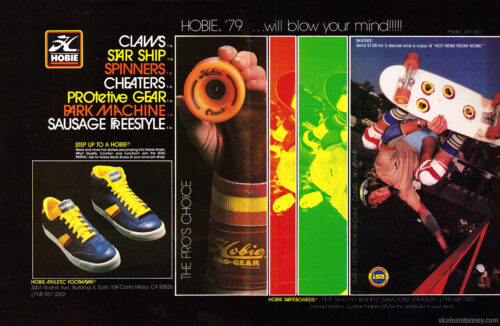





Thanks! That was good read!
very good insider’s view.
Really through info!!! Great detail in explaining the evolution and disappearance of the 4130 trucks!
i got the san diego chrome trucks for christmas. i remember grinding on christmas day only to see the chrome plating peel off.. it really wasnt the best idea, i was pretty upset too
Skating a pair of G&S chromoly trucks now and love them. They turn pretty much like Indy 169s and they grind everything better. Only problem is that the pivot cups cracked apart…thirty years old…and they are proprietary so there’s no perfect fit with replacements.
Where did you find them? I remember skating G&S trucks back in the early 90s and I LOVED them. Only a couple on eBay but they are WAY overpriced.
This comment I’m replying to is a year and half old but anybody reading this should know that you can by small blocks of PU at whatever Duro you like in any color you like. And from that someone with modest wood working tools can cut, shape, replicate or mold whatever parts they wanted. Like grab rails, skid plates, nose bones, and even pivot cups which are the easiest. Just slowly heat up a small chunk of PU about 90 duro and when it’s soft enough stuff it into the pivot cup and then press your hanger pivot into the cup and wiggle it a round a bit. Leave in till it cools, about ten mins then a dab of bearing oil to help pop it out and remove from whichever end it’s stuck in and trim with scissors and a little sand paper and there you go, hand poured pivot cups. Just like ACE.
I loved my Trucks until I realized I broke the baseplate. When I replaced them in 99 RipCity tried their best to hide them before I left the store:)
Sitting in my storage room I’m thinking about EBay replacing or maybe seeing if they fit into other brands baseplates. Think they would plug into Indys or other?
I got few like 3 sets of San Diego trucks but the ones down bottom of this ad they triangle version like a stealth bomber looking trucks.. I have like I think collection of just over 100 skateboards and 3 of my decks have the San Diego trucks.. I just put a set I just bought on ebay on my reissue gangster mark lake deck with og bullet wheels.. looks really rad.. yes I live in Maine and we used to skateboard back then uphere. I graduated in 1993.. only got left back in my 4th grade.. but I’m originally from Brentwood long Island NY and in 85 my mom moved her and I to Cambridge Maine.. I used to pen pal many companies in skateboarding and riders. I got Tony hawk’s Andrew Reynolds deck he rode at ymca in Encino cali it’s in the white thick magazine all about Tony hawk , it’s a Andrew Reynolds deck with 3 faces on it.. Tony hawk mailed it to me in 96 Era. I used to give free ideas to some the companies and had fun skateboarding.. I’m 48 oldfart now on ssi now because the mill jobs I had took a toll on me uphere in Maine..
Well that son of a gun mark lake skateboard must’ve sold already cause I looked all over eBay and elsewhere for it. And I know which San Diego trucking trucks you bought too I had them in my cart probably for a month and then one day !Poof! gone with only one other set way over priced remaining in all of internet land. Robert what is your EBay handle so I can keep a look out. I’m thrill76 on eBay and a quick way to find me is look for a G&S barking dog complete on G&S phase 2 trucks and you’ll find me. I graduated 94 on the exact opposite side of the continent from you down is San Diego, Ca from Vista. A little town that was the center of the universe for skateboarding in a two year span of 90 and 91. Even now as the dust has settled from skateboardings Wild Wild West upheavals from ‘90-05 with every skater you ever met gunning to own their own company, and filling the newly built industrial offices from Carlsbad to Escondido with every kind of Jamie Thomas wannabe and fake ass Damon Way look-a-like skate brand you can imagine; even now, no place on earth is home to more professional skateboarders than San Diego County. Particularly the 10 square miles of North County. So awesome to have the heroes of an entire generation so accessible and still so down to earth. But I wish we still had Transworld. I digress.
Hi, my name is Bastian, I’m from Germany. On my first real Skateboard in the late eighties, it was the Blind Danny Way o.c. Bladerunners Deck. When I started skating again after over 25 years now I found the trucks at my parents house and now using them on an oldschool reissue board for my miniramp. I like these trucks not only because of their outstanding design but also for their nice driving behavior, perfect for a 45 year old guy doing one of the best things on earth…skateboarding
I need replacement bushings for my stealth trucks. I can’t find anything on these trucks except this article. The pivot bushing is larger than normal trucks. Help meh!
Great read, I love my G&S trucks. Of course the base plates died about as quick as Tracker ones did. I replaced them with Indy base plates, while not a perfect fit they are close enough to work. My axles may have a slight bend but I can’t think of riding anything else.